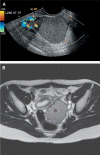Clinical practice. Endometriosis
- PMID: 20573927
- PMCID: PMC3108065
- DOI: 10.1056/NEJMcp1000274
Clinical practice. Endometriosis
Abstract
A healthy 25-year-old woman presents with worsening dysmenorrhea, pain of recent onset in the left lower quadrant, and dyspareunia. She has regular menstrual cycles, and her last menstrual period was 3 weeks before presentation. How should this patient be evaluated and treated?
Figures



References
-
- Giudice LC, Swiersz RO. LM, Burney Endometriosis. In: Jameson JL, De Groot LJ, editors. Endocrinology. 6th ed. Elsevier; New York: 2010. pp. 2356–70.
-
- Goldstein DP, deCholnoky C, Emans SJ, Leventhal JM. Laparoscopy in the diagnosis and management of pelvic pain in adolescents. J Reprod Med. 1980;24:251–6. - PubMed
-
- Eskenazi B, Warner ML. Epidemiology of endometriosis. Obstet Gynecol Clin North Am. 1997;24:235–58. - PubMed
-
- Bulun SE. Endometriosis. N Engl J Med. 2009;360:268–79. - PubMed
-
- Berkley KJ, Rapkin AJ, Papka RE. The pains of endometriosis. Science. 2005;308:1587–9. - PubMed
Publication types
MeSH terms
Grants and funding
LinkOut - more resources
Full Text Sources
Other Literature Sources
Medical
